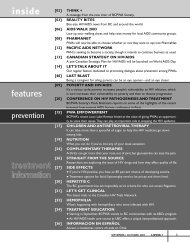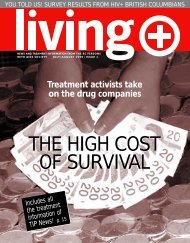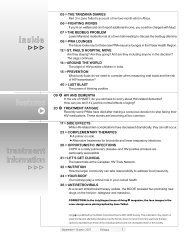liv poz mag.qxd - Positive Living BC
liv poz mag.qxd - Positive Living BC
liv poz mag.qxd - Positive Living BC
You also want an ePaper? Increase the reach of your titles
YUMPU automatically turns print PDFs into web optimized ePapers that Google loves.
Nutrition<br />
Nutrition and HIV,<br />
revisited<br />
Looking back at the role of nutrition in HIV treatment over the years<br />
by Diana Johansen<br />
Deciding to retire after 17 years of work in the HIV<br />
field has made me think about how nutrition has<br />
evolved over the past 25 years. Not only has our<br />
overall understanding of nutrition and health grown dramatically,<br />
but the specific nutrition issues facing people<br />
<strong>liv</strong>ing with HIV have also morphed and changed as HIV<br />
has become more of a chronic illness.<br />
Nutrition has always been an HIV issue. Before scientists<br />
identified the human immunodeficiency virus, when infected<br />
individuals were dying of wasting and malnutrition, some<br />
researchers were looking for a nutritional disease. At that<br />
time, vitamin and mineral (or micronutrient) deficiencies<br />
were prevalent, especially zinc. People with HIV died of<br />
opportunistic infections, and it was the loss of body cell mass<br />
due to profound wasting that ultimately led to people’s death.<br />
Without antiretroviral treatment, the only way to stay<br />
healthy and prolong life was nutritional therapy. The<br />
main focus of nutrition at that time was to get in enough<br />
calories and protein to prevent wasting, and to supplement<br />
with micronutrients to prevent deficiencies.<br />
Key learnings pre-HAART<br />
The era before highly active antiretroviral therapy (HAART)<br />
was a period of vigorous nutrition research, and many<br />
important findings helped guide nutrition education and<br />
intervention at that time—and still guide it today. Every<br />
major HIV conference had significant nutrition-related<br />
content. In 1995 there was the first of four international<br />
HIV nutrition conferences.<br />
At the time, we learned that the timing of death is<br />
related to body cell mass and survival is contingent on<br />
maintaining a body cell mass greater than 54 percent of<br />
the body. Body cell mass is the metabolically active tissue<br />
that does most of the work of keeping us a<strong>liv</strong>e. It<br />
includes muscle, organs, and other active cells types.<br />
It was also discovered that the body composition of PWAs<br />
changed over time. Body cell mass progressively declined<br />
even in those people who maintained the same weight.<br />
When weight loss did occur, body cell mass was preferentially<br />
lost over fat. These findings led to greater understanding<br />
about how chronic inflammation with abnormal cytokine<br />
activity affects the wasting process. Bioelectrical impedance<br />
analysis (BIA) became a common clinical procedure used by<br />
HIV dietitians to monitor body composition. A lot of BIA<br />
research was published at the time.<br />
Another key learning was that gut infection by HIV was<br />
considered a factor in wasting because of malabsorption. Also,<br />
futile cycling of nutrients contributed to wasting because<br />
the body did not use calories, protein, and fats properly.<br />
During this period, there was a lot of research on<br />
calorie and protein requirements. Earlier in the epidemic<br />
it was thought that PWAs had extraordinarily high calorie<br />
requirements. The educational materials of the day suggested<br />
consuming 3,000 or more calories a day; many people<br />
were <strong>liv</strong>ing on whipped cream, ice cream, and other fatty<br />
foods to increase calories.<br />
Studies showed that there was a 10 percent increase in<br />
calorie requirements for people with asymptomatic HIV (that<br />
is, people with HIV but no symptoms) and 20 – 30 percent<br />
increase for people with AIDS and/or opportunistic infections.<br />
However, this didn’t necessarily translate into a real increase<br />
because PWAs tended to decrease physical activity, which<br />
also has a significant impact on calorie requirements. The<br />
conclusion from all this was that there is an increase in<br />
requirements; with the amount depending on the individual.<br />
The studies on protein requirements concurred that<br />
PWAs needed higher protein to preserve body cell mass and<br />
provide substrate for an overstimulated immune system.<br />
The educational material of the day recommended protein<br />
intakes of about one gram per pound of body weight, but<br />
this was probably too high as the body can really only<br />
efficiently use about 0.5 – 0.75 grams per pound. Whey protein<br />
became a popular supplement to boost protein intake.<br />
Micronutrient deficiencies were common even among<br />
people who ate well. Deficiencies were associated with<br />
faster disease progression and increased risk of mortality.<br />
Initially this phenomenon was felt to be from malabsorption,<br />
but in the late 1990s the concept of increased turnover<br />
due to chronic inflammation became more popular. During<br />
this period, we learned a lot about oxidative stress and<br />
28 <strong>liv</strong>ing5 MayqJune 2010











